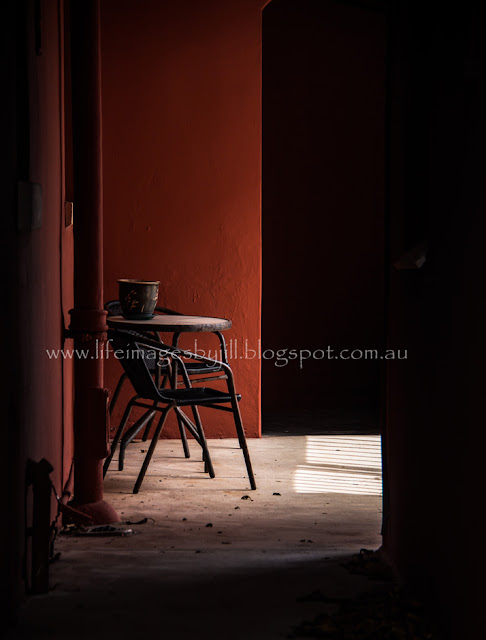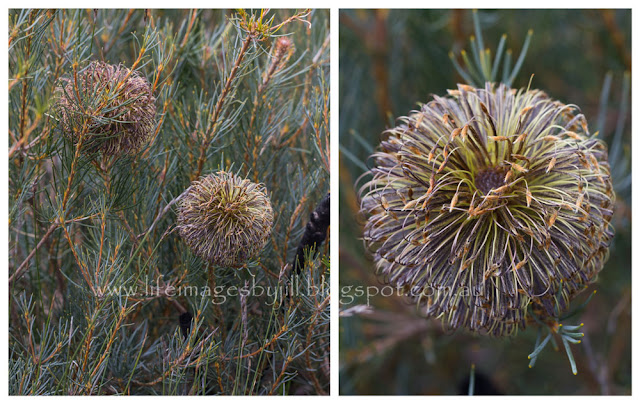Banksias are among Australia's most iconic plants. they were named after Sir Joseph Banks (1743-1820 ), who, in 1770, was the first European to collect specimens of these plants while on his voyage of discovery with Captain James Cook. Cook mapped the east coast of Australia which paved the way for British settlement 18 years later. Banksias belong to the plant family Proteaceae. Characterised by their flower spikes and woody seed cones they range from ground hugging plants to 30 metre high trees. There are 78 known Banksias, 76 species in Australia, 62 of which are endemic to Western Australia, and 30 of these growing between Esperance and Walpole on our southern coast. In recent years the genus Dryandra has been incorporated into the genus Banksia, so the genus now totals 173 species.
This one you see below here is the Candlestick Banksia - Banksia attenuata, commonly known as the candlestick banksia, slender banksia or biara to the Noongar people. This tall tree grows prolifically in the area where I live south of Perth.
Over the last couple of weeks I have spent time trying to identify some of the Banksia varieties we saw during our south coast travels in August to East and West Mt Barren, the Fitzgerald River National Park near Hopetoun, Tozers Bush camp near Bremer Bay and the Stirling Range National Park north of Albany.
Here are some of the Banksias I have been able to identify with the help of The Wildflower Society of WA's facebook page, Kevin Collins, Kathy Collins & Alex George's book Banksias, and Gillian Craig's book Native Plants of the Ravensthorpe Region.Thank you all!
I hasten to add I am not a botanist, but I have tried my best.
Below is the Showy Banksia - Banksia speciosa. It grows along the south coast from East Mt Barren to Israelite Bay. A shrub to 8 metres tall it flowers throughout the year, with a peak in summer and autumn. You can see in this photo the beginning of the flower, flowering, and then the seed head. These photos were taken near Esperance.
One of the most spectacular of the Banksias in Fitzgerald National Park is the Scarlet Banksia - Banksia coccinea. Also growing up to 8 metres, it grows from Albany to the Stirling Ranges, Fitzgerald National Park and east to Stokes National Park. It flowers from June to January. These photos were taken in the Stirling Ranges National Park but we also saw them widespread in the Fitzgerald National Park on the coast.
This one is the Lemann's Banksia - Banksia lemanniana. It is a shurb to 5 metres and grows near the south coast from West Mt Barren to Ravensthorpe. As you can see below, the flowers hang down. It flowers from October to January. We saw this one in the Fitzgerald National Park near East Mt Barren.
One of the largest Banksias flowers is the Woolly Banksia - Banksia baueri. A 2-3 metre high shrub it flowers from May to July, so these flowers you see here are finished. We saw this plant in Fitzgerald National Park and Tozers bush camp near Bremer Bay. It flowers from Kweda and Toolibin to Bremer Bay, east to Munglinup and also on the South Stirling plains.
Another banksia which had finished flowering when we visited is Baxter's Banksia - Banksia baxteri. We also saw this one in Fitzgerald and Tozers. It grows to 4 metres near the south coast from the Sitrling Ranges to Oldfield River east of Hopetoun. It flowers from December to May.

The one below shows how tough Banksias can be. This is the Suuthern Plains Banksia - Banksia media. We saw it clinging to the rocky cliff below the lookout at Cave Point in the Fitzgerald River National Park near Hopetoun. There is a huge variation in size of this plant from 10 metres to a prostrate 0.2metre shrub. It grows from the eastern end of the Stirling Ranges to Israelite Bay.
Flowering March to August these flowers you see here have finished.
I am told this is also the Southern Plains Banksia - Banksia media. In this variation the tips of the "perianth" are coloured. They can be grey, gold, pinkish-red, chocolate brown or even black. Below you see the side and above views.
The flower below we saw along the access road to Mt Trio in the Stirling Ranges National Park, in an area that had been completely burnt out prior to our visit in 2019 following the devastating summer bushfires. It was so heartening to see the bushland coming back.
I believe this is the Fox Banksia - Banksia sphaeracarpa - the botanical name relates to its spherical form. A shrub to 2 metres tall it has a wide range from the Darling Plateau east of Perth south to the Stirlling Range and Cape Riche.
I believe this ground hugging variety, which we saw growing at the Central lookout on the Stirling Range Drive, to be Banksia gardneri var brevidentata due to the short tooths on the leaves. It flowers from April to July and is restricted to the Stirling Ranges and a single population near Albany.
Well that is it from me today. It has been a fascinating journey tryng to identify these banksias. I learnt that the leaves of the different banksia varieties are all a bit different so it is important to photograph the leaves as well as the flowers.
Here is a close up of the Banksia fruit or nut. The follicles open to release the seeds. Sometimes this does not happen until the nut is burnt or completely dried out.
I have blogged about banksias before -
In celebration of the Australian Banksia
the Candlestick Banksia
Oh and just one more, not from the south coast but I am going to include it anyway just because I liked it and we saw it in a Banksia park near Esperance - Lesueur banksia or pine banksia - Banksia tricuspis. You can see how different the leaves of this banksia are. A small tree to 4 metres it grows around Mt Lesuer near Jurien on the west coast north of Perth and flowers from March to July.
Thank you so much for stopping by. I hope you have enjoyed seeing some of the 30 Banksia varieties that grow along our south coast region of Western Australia.
Here is a link to some more Banksia information:
Hello there! I love reading your comments. If you scroll down to the bottom you can comment too! I would love to hear from you.













































